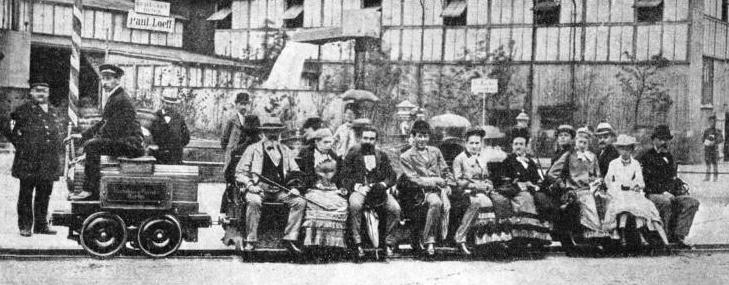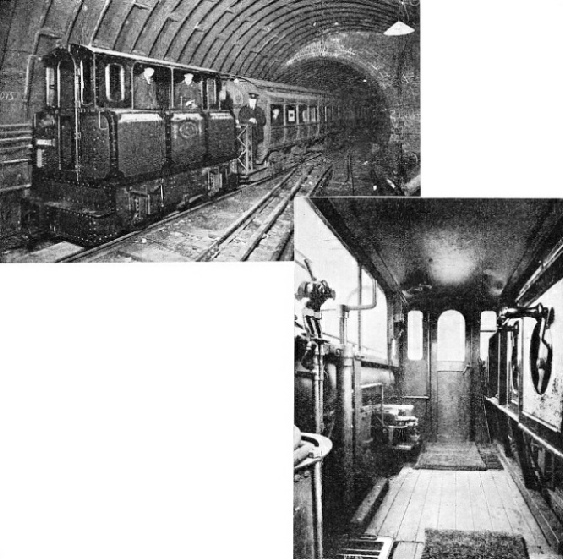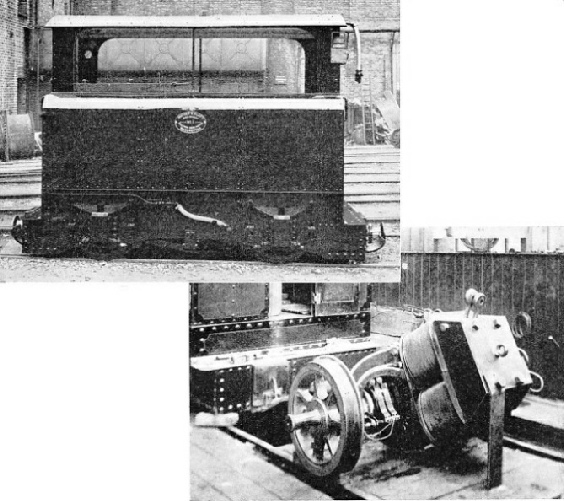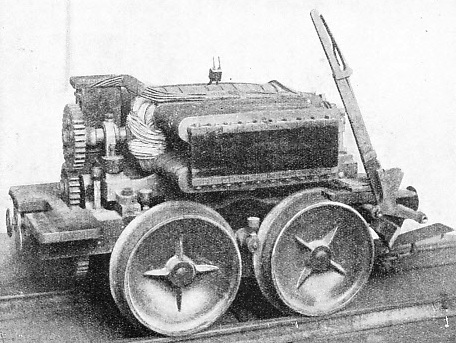
© Railway Wonders of the World 2024 | Contents | Site Map | Contact Us | Cookie Policy


Electric Traction
A Vital Development in the History of the Railway

THE SIEMENS ELECTRIC RAILWAY laid down at the Berlin Exhibition of 1879. The short line was about 600 yards long, and current was drawn from a third rail between the track which acted as the return to the dynamo. The locomotive hauled a maximum of some thirty passengers at a speed of about four miles an hour. This historic illustration shows one of the earliest trainloads of passengers, seated upon three carriages.
THE scientific wonder of to-
The electric locomotive and electric motor coach may be regarded as natural developments that have followed steam traction. New conditions have set new standards in railway travel. This is exemplified in the rapid development of electric suburban train services for the new built-
There can be no question that for comparatively short distances where stops are numerous, and fast and frequent trains are essential, the electric locomotive or electric motor coach has an enormous advantage over the steam engine. With their remarkable acceleration and efficiency in service, electric trains have solved the problem of transporting vast numbers of people over the great network of railway lines of the world’s suburban systems.
The use of electricity for traction purposes has made possible the Tube railways of great cities, and has contributed in no small measure to the successful operation of the longest tunnels, such as those under the mountain ranges of North America and the continent of Europe.
The first experimental electric railway in the world is attributed to Thomas Davenport, a blacksmith of Vermont, U.S.A., who exhibited a small railway operated by a miniature electric motor in 1835. A Scotsman named Robert Davidson built in 1838 an electric locomotive that attained a speed of four miles an hour. In England a patent was granted in 1840 for the use of rails as conductors of electric current, and similar American patents were issued to Lilley and Colten in 1847.
In 1847, also, Professor Farmer operated an electric car carrying two passengers at Dover, New Hampshire. Between that year and 1858 numerous experiments were carried out in various parts of the world, in which small rail-
In 1858, however, an unknown inventor discovered that the field magnets of a dynamo could be electrically energized by the rotation of its own armature. The next step forward in the development of electric traction was the invention, by Pacinotte, of the continuous current dynamo. This discovery was followed by the development of self-
This group of men, working quite independently, achieved the same result almost simultaneously in the years 1866-
The principle of the dynamo is, briefly, that if a wire be moved in the “field of force” of a magnet, an electric current will be “induced” or caused to flow in such wire. When the wires, wound on the drum armature, are made to revolve by mechanical means an electric current is produced. In non-
 THE CITY AND SOUTH LONDON TUBE RAILWAY was opened in 1890, and marked the progress of electric traction. This line was reconstructed between 1922 and 1924. The tubes of the original line had a 10 ft 2-
THE CITY AND SOUTH LONDON TUBE RAILWAY was opened in 1890, and marked the progress of electric traction. This line was reconstructed between 1922 and 1924. The tubes of the original line had a 10 ft 2-
IN THE CAB of any early City and South London Railway’s electric locomotive (right). These engines, running on four wheels, deriving power from a third rail, hauled forty-
A motor may be regarded as a dynamo “in reverse”; it revolves when current is applied to its windings, and so gives out practically as much power as that used for operating the dynamo. It is said that this reversibility was discovered by chance. A workman connected a dynamo to a live circuit, and was astonished to see the stationary armature begin to revolve.
Between the years 1867 and 1879 the development of the dynamo and motor went on apace, but no experimental attempts appear to have been made to apply electric traction to railways, except for a small battery locomotive in the USA in 1875.
At the Berlin Exhibition of 1879 some 600 yards of track were laid, on which a little three-
Siemens’ demonstration led to other exhibitions at Brussels, Düsseldorf, and Frankfurt. Siemens and Halske then built a line to Lichterfelde, near Berlin, one and a half miles long. This line, which was opened for traffic with one electric car in 1881, was the first public electric railway in the world. The motor was carried on a frame below the body of the car between the axles. Power was transmitted from the armature of the motor to drums on the driving axles by means of steel cables. The car carried twenty-
In the British Isles, the Brighton Electric Railway began to operate in August, 1883. Two years later an electric line was opened in Ireland between Bessbrook and Newry. Another early electric railway was that between Portrush and the Giant’s Causeway, in Northern Ireland.
Railway engineers in the United States were quick to appreciate the advantages offered by electricity. Many American cities adopted the new form of transport. At first electric traction was confined mainly to tramway work, but in 1883 the first electric locomotive for use on standard gauge railways made its appearance on the Mount Macgregor and Lake George Railroad in the State of New York. This electric locomotive was designed by Mr. L. Daft. In 1885 Mr. Daft built an electric engine that ran for several weeks on New York’s elevated railway, after which it was rebuilt. The engine was again in service in 1888.
In Great Britain the opening of the City and South London “Tube” Railway, in 1890, marked an epoch in the development of electric traction and had far-
The City and South London Railway was operated by electric locomotives -
The locomotives ran on four wheels, of 2 ft 3-
Each motor developed 50 hp, giving a tractive effort of 3,000 lb with an electric current of 226 amperes. The trains, weighing 40 tons, were hauled at an average speed of twelve miles an hour, with a maximum of twenty to twenty-
An interesting feature of these early locomotives was the use of the Westinghouse air brake. No motor-
The permanent way comprised flat-
 ELECTRIC LOCOMOTIVE No. 1 on the City and South London Railway. The engine had four wheels and weighed about 12 tons. It was 14 ft long and 6 ft 8½-
ELECTRIC LOCOMOTIVE No. 1 on the City and South London Railway. The engine had four wheels and weighed about 12 tons. It was 14 ft long and 6 ft 8½-
THE UNDERCARRIAGE of electric locomotive No. 1. The armatures -
The electrical conductor consisted of a light steel rail supported on glass insulators fixed to alternate sleepers. This conductor rail was set one inch below the level of the running rails, and wooden ramps were provided at points and crossings to carry the collectors over the rails, thus avoiding a short-
The collectors were connected, through a safety fuse and main switch, to a rheostat switch for use on starting. Current at full pressure cannot be led direct to the motors; it must be applied gradually through a rheostat or resistance. The current, after flowing through the motors, passes through the locomotive axle-
In 1893 the Liverpool Overhead Railway was opened, and this, from its beginning, was operated by electricity. The employment of steam locomotives was precluded owing to the proximity of the line to the docks.
Two important United States lines -
In Switzerland the Burgdorf-
The beginning of the twentieth century saw great developments in electric traction throughout the world, with the opening of the Central London, Paris Metropolitan, and sections of the Paris-
Rapid strides were taken in electrification during the following years. Between 1901 and 1906 many lines in America, England, Germany and Italy were built for electric traction. In 1902 the electric Berlin elevated line was first opened to the public. Many railways were electrified in the year 1907, notably that through the Simplon Tunnel, the New York Central suburban lines, and further sections of the New York, New Haven and Hartford Railroad. In the same year was opened the electric Hamburg-
In 1909 the first electric suburban service of the former London, Brighton and South Coast Railway was inaugurated, with overhead collectors on the trains for the electric current. This system of current collection has now been superseded by the third rail, and the old London, Brighton and South Coast lines now form part of the Southern Electric system, the largest electrified suburban service in the world.
Development of electric railways led to great improvements in design, not only in locomotives and coaches operated by electricity, but also in the generation and methods of distributing the electric current produced. Countries having great natural resources in the form of water power were quick to appreciate the advantages of electric traction.
Natural Power
In Switzerland, Germany, France and Italy huge power stations have been built at the feet of mountains, the pipes bringing unlimited water from the lakes and streams of the upper valleys to the great electrical generators far below.
Electric locomotives were put into service in 1914 for hauling heavy mineral trains on the Shildon-
A notable exception, however, was the great progress made in railway electrification in Switzerland. That country, without coal of her own and unable to obtain adequate supplies from other countries, was compelled to turn to her natural resources in the form of water power. To-
Enormous strides have been made in the USA in the development of electric traction, not only for suburban services, but also in the successful working of long-
The longest stretch of main line yet electrified in America, at the time of writing, is on the Chicago, Milwaukee, St. Paul, and Pacific Railroad. The 441 miles between Harlowton (Montana) and Avery (Idaho), on the main line from Chicago to Seattle, are worked by some of the most powerful electric locomotives in the world.
The route runs at altitudes varying between 2,500 ft and 5,800 ft, and the gradients are particularly severe. One forty-
Electricity for this line is generated by water power, as in Europe. Owing to the “switchback” nature of the route the effect of “regenerative braking” is used to the best advantage. The regenerative system of braking makes use of the power developed by an electric train on a falling gradient to produce electric current (the driving motors serving as generators), which is returned to the power station. Thus the power that is usually lost in braking a train is turned to useful account and economies are effected in operation.
There is no rivalry between the electric locomotive and the steam engine. The steam locomotive is to be preferred for long-
No comparison can be made between steam and electricity on a question of power. The former is limited by the pressure of the boiler and the size and number of its cylinders and wheels. An electric locomotive can, within the limits of the motor windings, draw on the resources of a huge power house.
Ma ny remarkable tests have been carried out to demonstrate the power superiority of the electric engine. A trial in the United States resulted in a 265 ton gearless electric locomotive pushing backwards a 278 ton steam locomotive of the “Mallet” type.
ny remarkable tests have been carried out to demonstrate the power superiority of the electric engine. A trial in the United States resulted in a 265 ton gearless electric locomotive pushing backwards a 278 ton steam locomotive of the “Mallet” type.
THE THREE-
You can read more on “Electrific Power on the Grand Scale”, “Electric Railways” and “Steam v. Electricity” on this website.